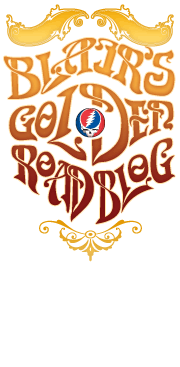After years of painstaking work and many months of preparation, the much-touted Grateful Dead Archive at UC Santa Cruz is set to open to the public with a celebration on Friday, June 29, between 1 p.m. and 4 p.m. Hallelujah!
The Archive’s first exhibition, A Box of Rain: Archiving the Grateful Dead Phenomenon, will be on display in McHenry’s Library’s custom-built 1,400-square-foot space, known as Dead Central, and that afternoon only, the popular Bay Area jam band Moonalice will play a free show outside the library building. A Box of Rain — and all exhibits at Dead Central—is free, as well. June 29 also marks the first day that a big chunk of the Archives’ holdings will be available for public viewing at the Library’s Special Collections and Archives.
“The opening day itself is going to be pretty low-key and casual,” says Grateful Dead Archivist and exhibition curator Nicholas Meriwether. “The highlight of the day is going to be Moonalice, who are going to play two sets at the base of the south lawn of the library. There will be light refreshments, a modest amount of speechifying, and people will be able to tour the exhibit.”
Back on April 21, I was part of a lucky group of folks who enjoyed a preview of the exhibition at a pre-opening donor thank-you dinner at the McHenry Library that drew an impressive crowd of Grateful Dead family, Dead Heads and Archive supporters. Among the guests that night were Trixie Garcia, Mountain Girl, Ice Nine Publishing head Alan Trist, Rock Scully (who gave a warm and witty keynote speech during the dinner), poster artists Stanley Mouse, David Singer and Gary Houston, Eileen Law (whose collection of Dead press clippings, photos and other fan-contributed artifacts formed the backbone of the Dead’s own archives), former manager Cameron Sears and Grateful Dead Hour host David Gans, among others.
The exhibition presents pieces from every era of the Dead’s history, including posters, photos, handwritten lyrics, fan art—literally hundreds of items, all beautifully displayed with clear and detailed explanatory labels; more than 10,000 words’ worth. It’s amazing how much Meriwether has managed to put into such a compact space. My favorite single item is a heartbreaking letter from Pigpen’s father, Phil McKernan, written to the band and GD management shortly after his son’s death. In it, he talks about his difficult relationship with Ron, and the healing he was fortunate to have experienced before Ron’s death—healing he attributes to the power and positiveness of the Dead, who were truly another family for him.
“That’s the most powerful piece in the entire exhibit as far as I’m concerned,” agrees Meriwether. “Although I have to say in the same breath, I loved also being able to put out, a few feet to the left of that, the letter that the band wrote to Richard Nixon when he was mired in Watergate difficulties. It says something to the effect of ‘While we don’t share anything at all in common politically, we’ve decided your removal would actually create serious difficulties. Therefore we’ve come up with a brilliant idea which we are not entirely sure you’re going to follow through with. But your problems would probably disappear overnight, as if by magic, if you were to chrome the entire White House!’ So it’s a combination of the sublime and the ridiculous, which is very Grateful Dead.”
More generally, Meriwether notes of the exhibition, “Part of the function of this show is to present the story of the Grateful Dead phenomenon, but it’s also the story of the Grateful Dead Archives. And those two themes sort of coil together and inform each other throughout the exhibit. So people who go through the exhibit get a very real sense of the band’s entire history, from their beginning in Palo Alto before the Grateful Dead all the way through their cultural diffusion out into the mainstream—it’s how they go from subculture/counterculture/hippie milieu to mainstream success.”
The Dead Central exhibition space was made possible by the generosity of the Brittingham Family Foundation (whose name adorns the space), spearheaded by Scott Brittingham, a Santa Barbara investor and philanthropist who was largely responsible for the renovation of the beautiful concert venue the Santa Barbara Bowl. “One of the centerpieces of the Santa Barbara Bowl refurbishment is the Jerry Garcia Glen, which features an enormous Jerry Garcia hand sculpture by Tom White,” Meriwether says. “Scott had Tom cast four smaller versions of the same hand, and we have one of them on display permanently outside of Dead Central.”
The Box of Rain exhibition will be in place for the next several months, at least, so if you’re in Santa Cruz, check it out! Its hours are the same as the McHenry Library hours, which vary day to day and week to week in the summer (and beyond). Unless you’re taking public transportation to get onto campus, you’ll need to purchase a parking permit, but the exhibit is free.
As for access to the Archive, “We split the original bequest of the archive into 12 sections, and we’re now at a stage where four of those 12 sections have been fully processed and can be made available to researchers,” Meriwether says. “That’s a good enough percentage to say, ‘Hey, we’re open for business.’ In the same breath, we explain to people that we get more donations every single week, so there is a lot of work still to be done. But in those four sections that are going to be accessible are press, photos, tickets, decorated fan envelopes, and backstage passes and posters. And once our website opens, people will be able to access about 45,000 digitized images from the archive.” As other sections and collections are processed in the coming months and years, they, too, will be made available to users and researchers in Special Collections.
On a personal note, I’m pleased to announce that the first batch of viewable offerings includes all 27 issues of my former labor-of love, The Golden Road magazine, which my wife, Regan, and I published between 1984 and 1993. I can’t think of a better digital home!
Lastly, on a somewhat related topic, Nicholas Meriwether has also put together a new book of mostly scholarly writings about the Dead called Reading the Grateful Dead: A Critical Survey, published by Scarecrow Press. “Starting in 2001, I edited a series of books called Dead Letters,” Meriwether says, “and what this does is it pulls together some of the best and most representative of the articles and features from those four volumes, plus the successor to that, which was the Grateful Dead Scholars Caucus conference program, and also from the peer reviewed journal I now edit, and which is published under the auspices of the Grateful Dead Archive here, called Dead Studies. The book is s snapshot of that developing discourse. You begin with pieces by Dennis McNally and John Perry Barlow and how that carries on through the years and a wide swath of disciplines. It’s like a kaleidoscope. There are a lot of different ways of viewing the Grateful Dead phenomenon.”
Indeed, the 24 pieces are divided into four sections—“Studying the Dead,” “Music and Lyrics, Medium and Message,” “The Deadhead Experience” and “Society and History, Contexts and Currents”—and within those there is an incredibly broad range of topics. A handful that caught my eye (though I have not yet read the book) include “And Closed My Eyes to See: Buddhist Resonances in the Grateful Dead,” “Terrapin Station, Postmodernism and the Infinite,” “The Psychedelic Experience, Contemporary Music and the Grateful Dead: A 1969 Study revisited,” “Deconstructing Deadheads” and “The Grateful Dead Religious Experience.” Just a little light summer reading!
For more about the UCSC Grateful Dead Archive go to their cool and informative website.





